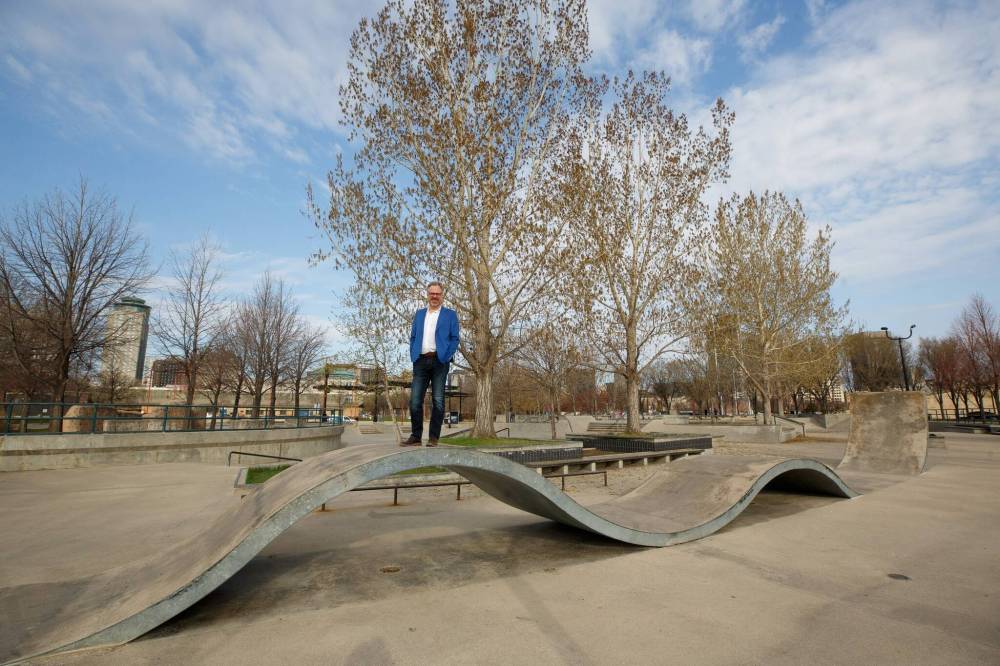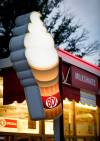Skateboarding The Forks From counterculture to civic pride
Read this article for free:
or
Already have an account? Log in here »
To continue reading, please subscribe:
Monthly Digital Subscription
$0 for the first 4 weeks*
- Enjoy unlimited reading on winnipegfreepress.com
- Read the E-Edition, our digital replica newspaper
- Access News Break, our award-winning app
- Play interactive puzzles
*No charge for 4 weeks then price increases to the regular rate of $19.00 plus GST every four weeks. Offer available to new and qualified returning subscribers only. Cancel any time.
Monthly Digital Subscription
$4.75/week*
- Enjoy unlimited reading on winnipegfreepress.com
- Read the E-Edition, our digital replica newspaper
- Access News Break, our award-winning app
- Play interactive puzzles
*Billed as $19 plus GST every four weeks. Cancel any time.
To continue reading, please subscribe:
Add Free Press access to your Brandon Sun subscription for only an additional
$1 for the first 4 weeks*
*Your next subscription payment will increase by $1.00 and you will be charged $16.99 plus GST for four weeks. After four weeks, your payment will increase to $23.99 plus GST every four weeks.
Read unlimited articles for free today:
or
Already have an account? Log in here »
Hey there, time traveller!
This article was published 10/05/2023 (941 days ago), so information in it may no longer be current.
Ever since someone got the idea to nail rollerskate wheels to a piece of wood, skateboarding has been a swooping, swerving, 3D mode of exploring urban space.
It’s been a way of finding new uses for existing structures and surfaces. That could mean “asphalt surfing” along hillside residential roads, taking over downtown corporate plazas left deserted on weekends, or skating the concrete curves of drained suburban swimming pools.
Landmarks
A monthly series that looks at the structure and spaces that shape Winnipeg.
Read more of Alison Gillmor’s Landmarks features here.
From its beginnings in mid-20th-century America, skateboarding has engaged with the physical topographies and social dimensions of the city.
At the Plaza at The Forks, a purpose-built park in the city core incorporated urban features beloved by skaters. Designed by British Columbia-based skate-park specialists Van Der Zalm + Associates and New Line Skateparks, in partnership with Winnipeg’s Scatliff+Miller+Murray, the skate plaza and bowl complex opened in June 2006.
It was a dream job for Bob Somers, a Winnipeg landscape architect and skateboarder who worked on the project.
“I grew up skateboarding in the 1980s, and I remember when mayor Bill Norrie and the council made it illegal,” he recalls. “Once or twice I found myself in the back of a cop car, getting a ticket.”
MIKE DEAL / WINNIPEG FREE PRESS Bob Somers was one of the key designers The Plaza skatepark at The Forks. 
Somers, a principal with Scatliff+Miller+Murray, found a certain full-circle satisfaction in being part of the multidisciplinary team that designed and constructed a permanent place for skateboarding, in the middle of one of Winnipeg’s most valued and popular public spaces.
“I ended up having to present the design to the board at The Forks,” Somers relates. “And the chair of the board at the time was Bill Norrie.”
The Plaza, Canada’s largest urban skate park, is made up of 44,000 square feet of stair sets, banks, rails and ledges, as well as a big bowl with complex, curving concrete planes.
Used by skateboarders, BMX riders and inline skaters, it also incorporates sculptures — some skateable — and other art.
The busy, dynamic site gets great reviews from both skaters and design professionals. The skaters cite the “slappy ledges,” “grindable angled walls,” “a super elevated steel ribbon track” and “a fun flat bank to barrier.”
JOE BRYKSA / FREE PRESS FILES
The Plaza got a big publicity bump in 2007, when it was highlighted in skateboard superstar Tony Hawk’s Secret Skatepark Tour 3.
Landscape architects and urban planners, meanwhile, are impressed by the project’s sensitive response to a culturally and historically significant site, and its integration into Winnipeg’s urban context. The Plaza won a Canadian Society of Landscape Architects Award of Excellence in 2007.
A national historic site, The Forks incorporates layers of the past. It was an important Indigenous meeting place for thousands of years, and was once a hub for river and rail transport, trading and immigration. The multi-use destination now combines recreation and green spaces, cultural and spiritual sites, stores and restaurants.
The Plaza is within sight of the Esplanade Riel and the iconic facade of the St. Boniface Cathedral.
“It was also built at the front door of what would become the Canadian Museum for Human Rights,” as Somers points out. It was crucial, he suggests, “to create a people space.”
“We were conscious of thinking about it almost as a sculpture garden or sculpture plaza. The question was how to connect the different geometries — to use ‘archi-speak’ — how to connect to all the things that were happening around there, like the outdoor stage and the museum entry.
“How do we tie these stories together, and how do we make this a place for non-skaters?”
WAYNE GLOWACKI / FREE PRESS FILES A crane placed a 42,000 pound concrete bowl on it’s side to be the central feature for the skateboard park.
That last question was especially important for Somers, who still remembers being chased by security guards at a time when the relationship between skaters and non-skaters could be fraught.
“The whole intent was to bring together skaters and the larger public. We recognized that The Forks is a people place, and this had to be for everyone.”
On a recent sunny spring day, the Plaza was filled with skaters — kids and young adults and some families — but there was also room for folks who just wanted to watch the hypnotic flow of boards on concrete.
“Skateboarding really is a spectator thing,” Somers says.
MIKE APORIUS / FREE PRESS FILES The busy, dynamic site gets great reviews from both skaters and design professionals.
The design process for the Plaza involved a lot of consultation and co-operation.
“It took a lot of design time back and forth, and it was a really interesting and fun team,” Somers recounts. “We had the expertise of the skate-park builders from out west and then the careful collaboration with our team to think about what it meant for The Forks, both short-term and long-term, recognizing that it was the start of a lot of development there.”
Almost immediately, the Plaza helped to bring in an influx of young people, “a whole new demographic,” Somers says. After it opened, “(Forks CEO) Paul Jordan told us about the trends they were seeing at the Market. All of the sudden, the guy who’s selling fried chicken, his sales went up 700 per cent.”
There were some engineering challenges. Skateboarding was born in the sunny southern California climate, but this Winnipeg park experiences extreme temperature fluctuations and has some tricky soil conditions.
“There was no structural capacity in the soil at The Forks because it had been a dumping ground for years,” Somers explains. The park had to be built on 200 concrete piles driven deep into the earth.
MIKE DEAL / WINNIPEG FREE PRESS As a teen, Bob Somers was once ticketed for skateboarding.
Somers still remembers opening day: “There was a really big plan. They brought all these professional skaters to town, and there was this whole thing where the pros were going to be skating in the park. Fireworks would go off and the walls would come down, and you’d see these bigtime pros,” he says.
But the official speeches were unusually short, and as the walls were about to come down, the pros were still at the patio at the Inn at the Forks eating lunch. “And everyone’s panicking, trying to get them to the park as the fireworks are going off, and then all the kids are there pushing them out of the way because the kids just wanted to skate, and they didn’t care about the pros.
“The enthusiasm was incredible.”
For Somers, the Plaza remains a deeply personal project.
“It’s a happy place for me, as someone who grew up as a skateboarder,” he says. “There was a period in my life when skateboarding was the most important thing in the world to me and I did it every day. I just loved doing this thing.
“And to be able to go there all these years later and see that it’s still the same — there are all these random people connected by this activity, this creativity. That means a lot.”
alison.gillmor@freepress.mb.ca

Studying at the University of Winnipeg and later Toronto’s York University, Alison Gillmor planned to become an art historian. She ended up catching the journalism bug when she started as visual arts reviewer at the Winnipeg Free Press in 1992.
Our newsroom depends on a growing audience of readers to power our journalism. If you are not a paid reader, please consider becoming a subscriber.
Our newsroom depends on its audience of readers to power our journalism. Thank you for your support.







